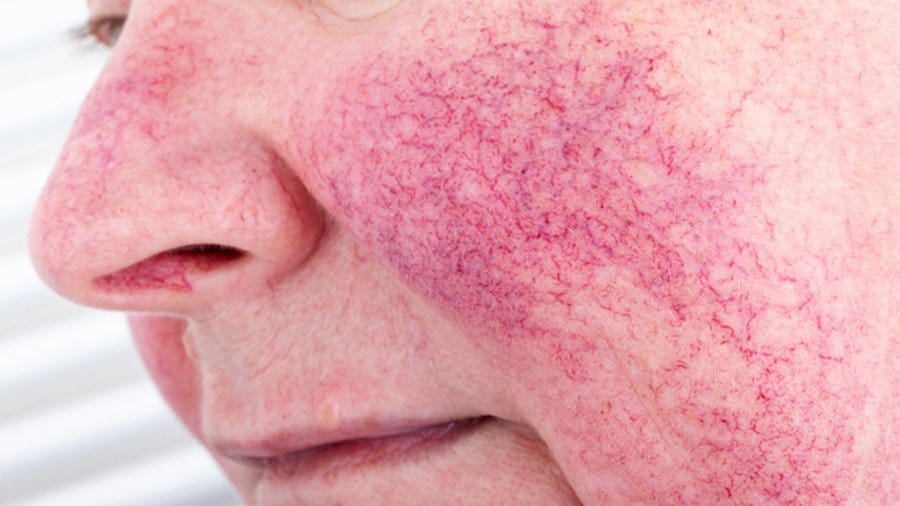How Different Rosacea Types Are Treated, According to a Derm
Most people associate rosacea with flushed skin and visible blood vessels, but this chronic inflammatory condition can affect the skin in many ways. In fact, there are different subtypes of rosacea, which come with...Friday, March 13th 2020, 9:01 am
Most people associate rosacea with flushed skin and visible blood vessels, but this chronic inflammatory condition can affect the skin in many ways. In fact, there are different subtypes of rosacea, which come with different symptoms and may require unique types of treatment.
“There are four types of rosacea,” says Michelle Henry, MD, dermatologist in New York City. “The first is erythematotelangiectatic rosacea, there's papulopustular rosacea, there's phymatous rosacea, and there's ocular rosacea.”
Erythematotelangiectatic Rosacea (ETR)
This subtype of rosacea is the most common and the most mild form of rosacea. It causes flushing and flat, red patches on the face. It may also cause sensitive skin with swelling, stinging, scaling, or dryness.
“If you have the mildest form of rosacea, which really presents with just red flat patches and sometimes a few blood vessels, one of the best treatments is actually laser [therapy],” says Dr. Henry. Laser and light-based therapy do not cure rosacea, but regular sessions can help reduce flushing and visible blood vessels.
Two topical treatments for ETR include brimonidine gel and oxymetazoline cream. These are typically only used for more severe versions of ETR that cannot be controlled by lifestyle changes alone. (Learn more about lifestyle changes to manage rosacea flares here.)
Papulopustular Rosacea
This type of rosacea may cause flushing and other symptoms of ETR, but its textbook feature is papules and pustules—or in layman's terms, zits. In fact, it is sometimes called “acne rosacea.” It may also cause oily skin and raised patches of skin (plaques).
Because papulopustular rosacea is more severe than ETR, the treatments may require more than lifestyle changes. “We’re using slightly more aggressive creams and sometimes oral medication,” says Dr. Henry. “Sometimes I’ll use a very, very low dose oral antibiotic, and it’s so low dose that it’s no longer working as an antibiotic, but it’s really just working as an anti-inflammatory medication to help reduce that inflammation.”
Topical creams for papulopustular rosacea include azelaic acid, metronidazole, sodium sulfacetamide, and retinoid.
Ocular Rosacea
This subtype of rosacea may cause similar symptoms as ETR or papulopustular rosacea, but near and around the eyes. It can cause red and watery eyes that are irritated, dry, and sensitive to light. It often results in swollen eyelids that may be crusty or have cysts. Ocular rosacea can be dangerous since there is a risk of complications to the vision.
Someone with ocular rosacea may benefit from similar treatments as ETR and papulopustular rosacea, but they may also need to see an ophthalmologist. Ocular rosacea symptoms may require topical antibiotics or cyclosporine, and warm compresses may help.
Phymatous Rosacea
This less common type of rosacea may occur after years of another type of rosacea, like ETR. Phymatous rosacea is named after its main symptom: phyma, or a thickening of the skin. The inflammation in the skin causes the sebaceous glands to expand, causing thickened skin, particularly on the nose (rhinophyma).
Unfortunately, once phyma occurs, it can only be removed surgically, using methods like dermabrasion, scalpel excision, and electrosurgery. The goal of these surgeries is to break down the thickened skin and reconstruct the nose to its former appearance.
“We have some really great treatments to really reduce and control rosacea,” says Dr. Henry. “I would really encourage [you] to seek out professional help, because we can really maintain [your] condition.”

All rights reserved.
More Like This
March 13th, 2020
April 15th, 2025
April 5th, 2025
Top Headlines
May 1st, 2025









